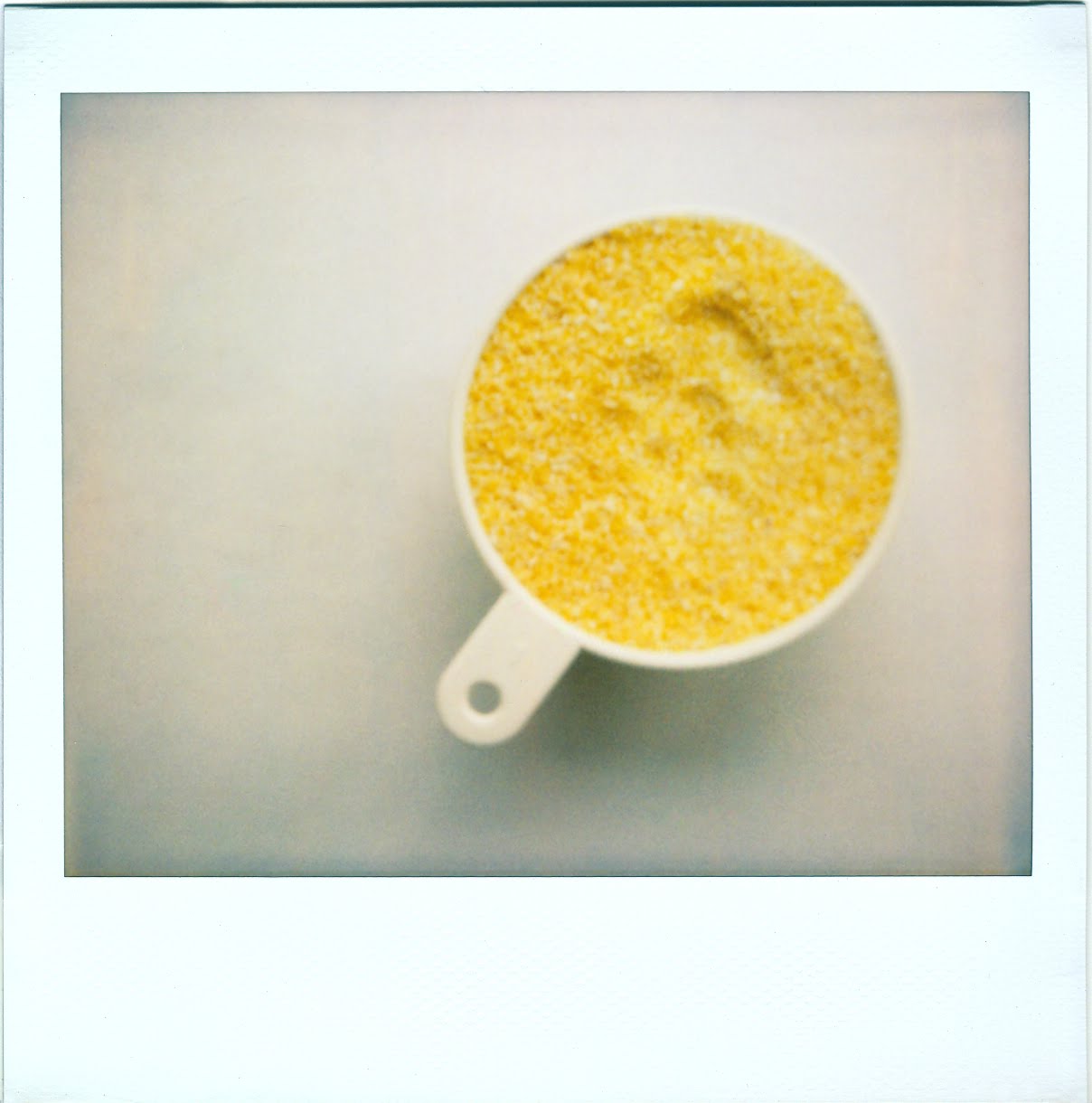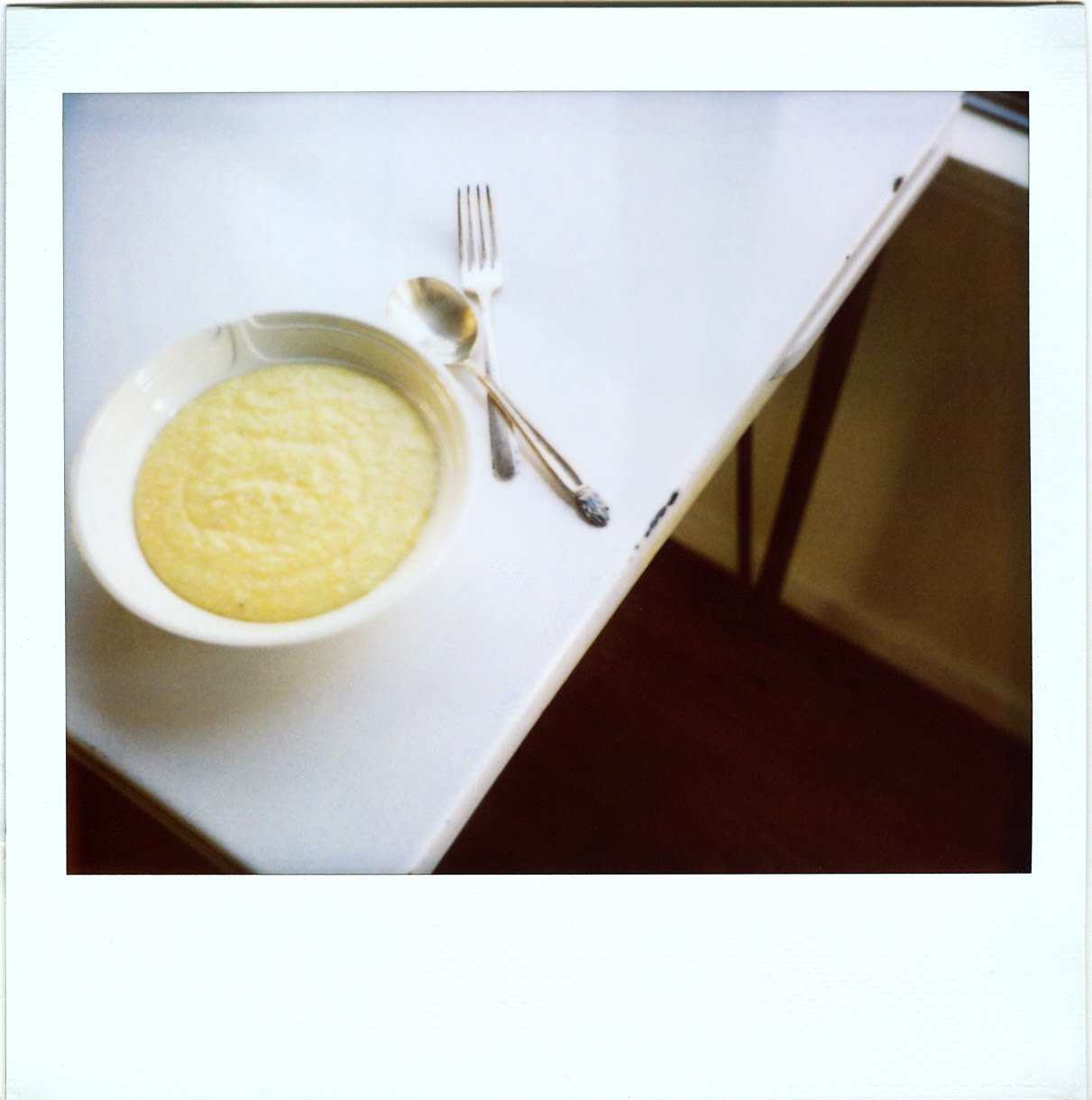A reasonable question
I have been, for quite some time, intimidated by polenta. I don’t like saying that out loud, because it makes me sound like a total cream puff, but in the spirit of keeping it real, I’m saying it. I’m willing to own it. I will also say, however, that as of a few days ago, I am not intimidated by polenta anymore. And I have Judy Rodgers to thank for that.

I don’t know where it got its start, this idea that polenta is so tricky to make, but it’s the common line. It’s what I was always told. They say you have to sprinkle the cornmeal into boiling water in a particular way, like a rain shower, and that you have to stir constantly. Rumor has it, if you put down your spoon and step away, or if you try to do anything that is not constant stirring, your polenta will go lumpy, irretrievably lumpy, to spite you. I remember my mother making polenta once, sometime in the late 80s. She had eaten it in a restaurant, served soft with sauteed mushrooms on top, and she decided to try it at home. She studied up in all the right places, and then she did as she was told: she stood at the stove and stirred, and stirred, and stirred, for over an hour. She was intense. She was devoted. And it was beautiful: the pure flavor of corn, only softer and richer, more deeply satisfying. But I don’t remember her ever making it again.
I tried making polenta once, in college. I didn’t know that the possibility of lumps in one’s corn gruel could cause a person real anxiety, but it did for me. It’s not that making polenta is actually difficult; it’s just that, because of all the dos and don’ts that come with it, I was sure that I was doing something wrong. I felt like my dinner and I were teetering on the edge of some precipice, a precipice over an abyss of lumps, and I didn’t know if we were ultimately going to fall, or how I could tell if we were falling, or how long I was going to have to stand there, teetering, by which I mean stirring, before we were rescued. (I’m prone to nightmares.)
So I started buying polenta in tubes, a simplified situation that requires only slicing. But it was never very good, and certainly not as good as freshly cooked soft polenta. After a while, I stopped eating much polenta at all, except in restaurants. But you don’t find it much on menus anymore – or not as often as you did in the 80s, when it had its big break – so, basically, what I’m trying to say is that I have been living a life devoid of polenta for quite some time. Whether or not that counts as a life is a reasonable question.
Anyway, I’d been thinking about that a lot lately, and then I saw, in the New York Times, that Mark Bittman was writing about polenta. I decided that the time had come. I gathered up a few recipes, including Bittman’s, and I compared them: some had you fuss until Forever, some promised that it was quick and easy, and some even used an oven method that requires no human intervention at all. What I decided on was something in between, the polenta from The Zuni Café Cookbook, by Judy Rodgers.
If I haven’t made this clear, I’m going to say it now: I totally love this book. It might actually be my favorite cookbook, and those are big words to throw around. I had been ignoring its polenta recipe for reasons cited above, but I should have had more faith, because it is brilliant. BRILLIANT.
Zuni has had polenta on its menu for a long time, and it’s perfect: served soft, with Parmesan, mascarpone, or nothing. I always wondered how they made it in a restaurant setting, where each cook is working on a thousand things at once, and how they served it so quickly, without any kind of wait or delay or allowance for stirring time. The answer, it turns out, is two-fold.
First, Judy Rodgers doesn’t(!) adhere(!) to the constant stirring rule. I love her. You need to stir often enough, she says, to keep the polenta from sticking or scorching, but you don’t need to hover over it. Using a heavy-bottomed saucepan is important, and you want to keep the heat gentle, so that the polenta bubbles only occasionally, slowly, like lava. If you stir every five minutes or so, you should be fine. Second, and this is the brilliant part, brilliant brilliant brilliant: after the polenta has cooked, you hold it in a double boiler, or in some sort of contraption over simmering water, for anywhere between thirty minutes and a few hours. Judy Rodgers says that this holding period is key, that it allows the cornmeal to swell and soften even more, making it especially creamy. And it does. Not only does it make for a better, more tender, lighter polenta, but it’s also so sensible. So humane. So handy! It means that, if you want to, you can make your polenta, your brilliant polenta, a couple of hours ahead and keep it hot until you want it.
If I were you, I would make it immediately, for breakfast, lunch, or dinner. Whichever comes first.
Zuni Café Polenta
Adapted from The Zuni Café Cookbook, by Judy Rodgers
I use Bob’s Red Mill brand corn grits polenta, which is not fancy, but it works fine.
Bring the water to a simmer in a 2-quart saucepan. Whisk or stir in the polenta, then stir until the water returns to a simmer. [I did this step, and the steps that follow, with a whisk.] Reduce the heat until the polenta only bubbles and sputters occasionally, and cook, uncovered, for about 1 hour, stirring as needed, until thick but still fluid. If the polenta becomes stiff, add a trickle of water. Taste. Add salt and a generous dose of butter. [I used 2 teaspoons of kosher salt and about 2 tablespoons of butter.]
Transfer the polenta to a double boiler set over simmering water. Wrap the lid tightly in plastic wrap (*see note) and cover the polenta. Allow the polenta to rest that way for at least 30 minutes – or up to a few hours, depending on your schedule. If you don’t have a double boiler, you can make a close approximation by setting the saucepan containing the polenta on a small, ovenproof ramekin centered inside a wider, deeper pot, and surrounding it with barely simmering water. Cover the pan as directed above.
Serve hot. If you want, grate some Parmigiano-Reggiano on top, though I like mine plain.
Note: The plastic wrap doesn’t seem like great idea to me, but I’m not sure. Heating plastic can cause it to release chemicals, but since this plastic wrap isn’t actually touching the food, is it safe? I followed the recipe as directed, but I wanted to raise the question. If you’re worried, maybe skip the plastic wrap? Or instead, try placing a sheet of parchment over the saucepan, under the lid?
Another note: This polenta would also be delicious with a spoonful of tomato sauce or meat sauce, or with some sliced sausage. You could also serve it with some sort of braised beef or pork. I had polenta topped with duck ragu and a fried egg at Flour + Water in San Francisco, and it was out. of. control.
The last note: If you have leftover polenta, spread it about 1 inch deep in a lightly oiled baking dish. Allow it to cool, and then refrigerate until you’re ready to roast, grill, or fry it.
Yield: 4 to 8 servings


